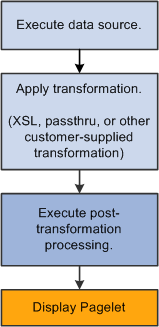Using Pagelet Wizard Post-Transformation Processing
This section provides an overview of Pagelet Wizard post-transformation processing and discusses how to:
Insert message catalog text.
Format Date, Time, DateTime, Currency, and Number elements.
Disable WSRP style substitution.
Insert a content-reference-based link.
Insert a content reference URL as text.
Generate charts.
Insert pagelet headers and footers in specific locations.
Pagelet Wizard enables you to use delivered Pagelet Wizard builder transformation tasks in custom and passthru transformations.
Listed in the order in which they are run in post-transformation processing, the following transformation tasks are not automatically generated for custom and passthru transformations, but they can be added by means of embedded tags:
Insert Message Catalog text.
Format Date, Time, DateTime, Currency, and Number.
Insert content-reference-based links.
Insert content reference URLs as text.
Generate charts.
Insert pagelet headers and footers in specific locations.
These tasks are handled by the Post Transformation step, which is built into Pagelet Wizard.
Image: Pagelet Wizard pagelet-display processing flow
The following diagram illustrates the point at which the Post Transformation step runs in the process flow for displaying a Pagelet Wizard pagelet.

The Post Transformation step runs after the completion of the Transformation step. Following the Post Transformation step, the Pagelet Wizard pagelet appears for the user. Pagelet Wizard uses embedded tags to identify the type of Post Transformation processing that occurs.
Tags that perform these post-transformation tasks can be placed in the HTML for HTML pagelets using the passthru transformation, or in the XSL for pagelets using a custom transformation. For all other transformations—such as chart, list, table, and so forth—Pagelet Wizard automatically generates the tags when necessary. These tags are primarily meant to be used by pagelet designers who want to create custom pagelets using functionality similar to what our delivered Pagelet Wizard builders provide.
Use the following syntax to insert the text of a message catalog entry. Variables that are user-supplied are italicized.
Note: This processing step occurs only if the output of the Transformation step is XHTML-compliant.
See XHTML™ 1.0 The Extensible HyperText Markup Language (Second Edition).
|
Item to Insert |
XHTML Tag |
HTML After Processing |
|---|---|---|
|
Message Catalog Text |
<PSMSGTEXT MSGSET="message set" MSGNBR="message number" DEFAULT="defaulttext"/> |
Message text. |
|
Message Catalog Explain Text |
<PSMSGEXPLAINTEXT MSGSET="message set" MSGNBR="message number" DEFAULT="defaulttext"/> |
Message explanation text. |
Use the following syntax to format Date, Time, DateTime, Currency, or Number elements. Variables that are user-supplied are set in italics.
Note: This processing step occurs only if the output of the Transformation step is XHTML-compliant.
See XHTML™ 1.0 The Extensible HyperText Markup Language (Second Edition).
|
Item to Insert |
XHTML Tag |
HTML After Processing |
|---|---|---|
|
Date |
<PSFORMAT TYPE="DATE" [FORMAT="format string"][FORMAT_3 character language code="format string"]>DateToFormat</PSFORMAT> Note: FORMAT has the same syntax as the DateTimeToLocalizedString() PeopleCode Function. |
Formatted Date. Language-specific Formatted Date. |
|
Time |
<PSFORMAT TYPE="TIME" [SOURCETZ="Source Time Zone"][DESTTZ="Destination Time Zone"] [FORMAT="format string"]>TimeToFormat</PSFORMAT> Note: SOURCETZ and DESTTZ have the same format as the DateTimeToTimeZone() PeopleCode function. FORMAT has the same syntax as the DateTimeToLocalizedString() PeopleCode Function. |
Formatted Time. |
|
DateTime |
<PSFORMAT TYPE="DATETIME" [SOURCETZ="Source Time Zone"][DESTTZ="Destination Time Zone"] [FORMAT="format string"]>DateTimeToFormat</PSFORMAT> Note: SOURCETZ and DESTTZ have the same format as the DateTimeToTimeZone() PeopleCode function. FORMAT has the same syntax as the DateTimeToLocalizedString() PeopleCode Function. |
Formatted DateTime. |
|
Number |
<PSFORMAT TYPE="NUMBER" FORMAT="format string" [WIDTH="width"] [PRECISION="precision"]>NumberToFormat</PSFORMAT> Note: FORMAT, WIDTH, and PRECISION have the same format as the NumberToDisplayString() PeopleCode Function. |
Formatted Number. |
|
Currency |
<PSFORMAT TYPE="CURRENCY" FORMAT="format string" [WIDTH="width"] [PRECISION="precision"] [CURRENCY_CODE="CODE "] [CURRENCY_DECORATION="SYMBOL/CODE/BOTH "]>NumberToFormat</PSFORMAT> Note: FORMAT, WIDTH, and PRECISION have the same format as the NumberToDisplayString() PeopleCode Function. CURRENCY_CODE can be one of the supported PeopleSoft currency codes, or if left blank, the default is the user's currency code. CURRENCY_DECORATION can have the value of SYMBOL (currency symbol appears before the number), CODE (currency code appears after the number), or BOTH (the default). |
Formatted Number with currency symbol and/or currency code. |
Use the following post-processing tag to disable WSRP style substitution. <PSNOWSRPSTYLESSUBST/> takes no parameters and signals that the style classes referenced in the pagelet are already WSRP compliant. Including this tag can have a slight positive improvement in performance.
Use the following syntax to insert content-reference-based links into a Pagelet Wizard pagelet. Variables that are user-supplied are set in italics.
Note: This processing step occurs only if the output of the Transformation step is XHTML compliant.
See XHTML™ 1.0 The Extensible HyperText Markup Language (Second Edition).
|
Item to Insert |
XHTML Tag |
HTML After Processing |
|---|---|---|
|
Content Reference Link |
<PSREGISTEREDLINK PORTAL="portal name" CREF="content reference name" target="target" APPEND="append">Text of Link</PSREGISTEREDLINK> |
<A HREF="http…URL of content reference…[?/&]append" target="target">Text of Link</A> |
Use the following syntax to insert a content reference URL as text into a Pagelet Wizard pagelet. Variables that are user-supplied are set in italics.
Note: This processing step occurs only if the output of the Transformation step is XHTML-compliant.
See XHTML™ 1.0 The Extensible HyperText Markup Language (Second Edition).
|
Item to Insert |
XHTML Tag |
HTML After Processing |
|---|---|---|
|
Content Reference URL |
<PSREGISTEREDURL PORTAL="portal name" CREF="content reference name" APPEND="append"/> |
http…URL of content reference…[?/&]append |
Embedded charts are generated in the Post Transformation step.
For details about chart generation and its syntax, refer to the ChartXSLBuilder included in the EOPPB_PAGELET application class. You can access the ChartXSLBuilder application class code using PeopleSoft Application Designer.
Pagelet Wizard automatically inserts a pagelet's header in front of the output of the Transformation step, and it inserts the pagelet footer after the output of the Transformation step.
To alter this behavior, you must use special HTML comment tags. Here is the syntax of these tags:
|
Item to Insert |
HTML Tag |
XSL Equivalent |
|---|---|---|
|
Header |
<!--PWHEADER--> |
<xsl:comment>PWHEADER</xsl:comment> |
|
Footer |
<!--PWFOOTER--> |
<xsl:comment>PWFOOTER</xsl:comment> |